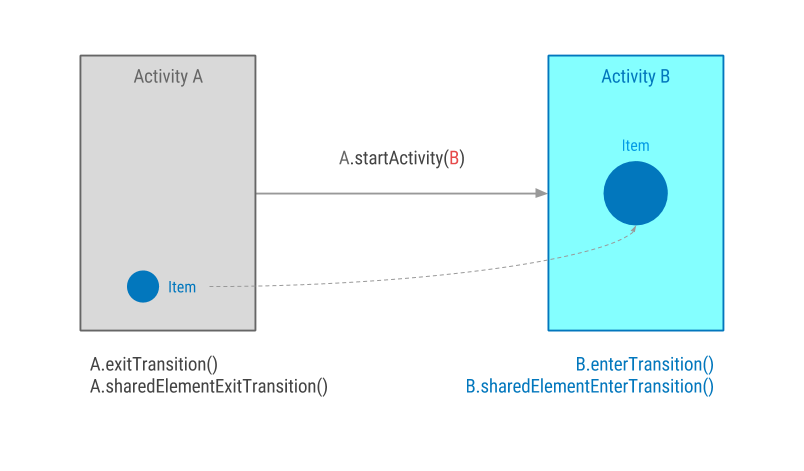版权声明:本文为博主原创文章,未经博主允许不得转载。 https://blog.csdn.net/wu_zi/article/details/78318203
最近工作不是很紧张,所以下载了“小秋魔盒”的代码在研究。整个应用使用了很多的第三方框架,用很简单的代码实现了比较炫的效果。
首页列表的item点击跳转页面效果比较好,于是研究了一下。
跳转源码:
//设置监听,监听是自己写的
homeAdapter.setOnItemClickListener(new OnItemClickListener() {
Intent intent = null;
@Override
public void onItemClick(View view, int position) {
// Toast.makeText(context, "这是第" + position + "个item", Toast.LENGTH_SHORT).show();
intent = new Intent(context, listActivity.get(position));
ActivityOptionsCompat optionsCompat = ActivityOptionsCompat.makeSceneTransitionAnimation(
getActivity(),
view.findViewById(R.id.iv_logo),
getString(R.string.transition_wechat_img)
);
ActivityCompat.startActivity(getContext(), intent, optionsCompat.toBundle());
}
@Override
public void onItemLongClick(View view, int position) {
}
});关键代码就是ActivityOptionsCompat.makeSceneTransitionAnimation。
查看了一下这个静态方法的源码:
/**
* Create an ActivityOptions to transition between Activities using cross-Activity scene
* animations. This method carries the position of one shared element to the started Activity.
* The position of <code>sharedElement</code> will be used as the epicenter for the
* exit Transition. The position of the shared element in the launched Activity will be the
* epicenter of its entering Transition.
*
* <p>This requires {@link android.view.Window#FEATURE_CONTENT_TRANSITIONS} to be
* enabled on the calling Activity to cause an exit transition. The same must be in
* the called Activity to get an entering transition.</p>
* @param activity The Activity whose window contains the shared elements.
* @param sharedElement The View to transition to the started Activity. sharedElement must
* have a non-null sharedElementName.
* @param sharedElementName The shared element name as used in the target Activity. This may
* be null if it has the same name as sharedElement.
* @return Returns a new ActivityOptions object that you can use to
* supply these options as the options Bundle when starting an activity.
*/
public static ActivityOptionsCompat makeSceneTransitionAnimation(Activity activity,
View sharedElement, String sharedElementName) {
if (Build.VERSION.SDK_INT >= 24) {
return new ActivityOptionsCompat.ActivityOptionsImpl24(
ActivityOptionsCompat24.makeSceneTransitionAnimation(activity,
sharedElement, sharedElementName));
} else if (Build.VERSION.SDK_INT >= 23) {
return new ActivityOptionsCompat.ActivityOptionsImpl23(
ActivityOptionsCompat23.makeSceneTransitionAnimation(activity,
sharedElement, sharedElementName));
} else if (Build.VERSION.SDK_INT >= 21) {
return new ActivityOptionsCompat.ActivityOptionsImpl21(
ActivityOptionsCompat21.makeSceneTransitionAnimation(activity,
sharedElement, sharedElementName));
}
return new ActivityOptionsCompat();
}注释大概的意思就是说,通过一个中间过渡的界面创造界面的中间过渡动画。
方法将一个共享元素的位置传递给要启动的activity。
共享的元素(就是界面中的某个view)将作为退出的界面的中心。
这个共享的view 也会是进入的新页面的中心。
哎,英语水平不佳,大概意思就是那样吧。

之前看过一个仿微信浏览照片的效果,也跟这个类似,
但是他的写法十分复杂还需要记录和计算位置,通过上面的代码非常简单。
只需要在退出和启动的两个界面中的某个view加上android:transitionName属性就行了。
属性的值要一样哦。
